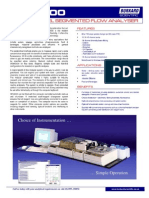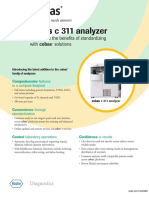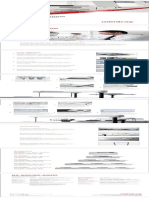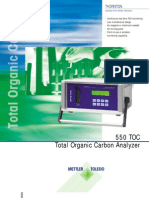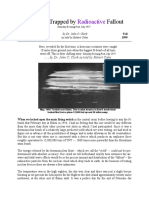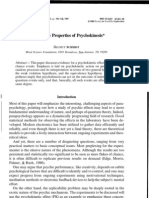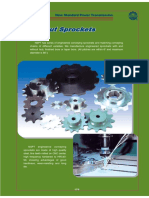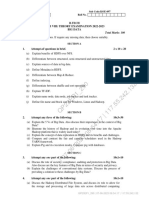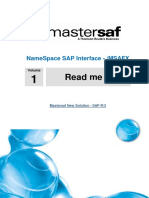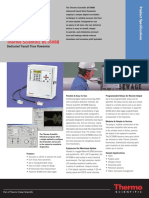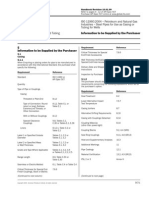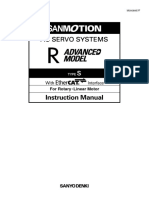Chapter 1introduction PDF
Chapter 1introduction PDF
Uploaded by
joseCopyright:
Available Formats
Chapter 1introduction PDF
Chapter 1introduction PDF
Uploaded by
joseOriginal Title
Copyright
Available Formats
Share this document
Did you find this document useful?
Is this content inappropriate?
Copyright:
Available Formats
Chapter 1introduction PDF
Chapter 1introduction PDF
Uploaded by
joseCopyright:
Available Formats
X L 300 SERVICE MANUAL
1
1.1 Introduction
This manual assumes a general understanding of the Transasia's, fully automated analyser XL300. It is
meant to compliment the XL300 operators Manual. If the reader encounters areas that are not fully
explained, Please refer to the operator's manual.
This manual does not intend to teach troubleshooting skills. It is designed to provide a competent
service engineer trained on the XL300, with the information necessary to maintain the XL300.
Certain sections of this manual like electronics, hardware etc. are subject to change. New revisions of
these documents will be sent as Engineering change records /Technical bulletins to the authorised
distributors of XL300
Optimum performance of the analyser is guaranteed only by the use of genuine parts, supplied by
Transasia.
Transasia will not be responsible for failures associated with the use of unauthorised parts or
modifications carried out by the distributor or customer.
In case of problems beyond the scope of the service engineer, Transasia is available for assistance and
at the following.
TRANSASIA BIO-MEDICALS LTD,
ADDRESS TECHNICAL SERVICES,
+ TRANSASIA HOUSE,
8, CHANDIVALI STUDIO ROAD
MUMBAI - 400 072
PHONE
) +91- 22 - 2857 4040
+91 - 22 - 2857 5050
FAX 2 +91- 22- 28575689
+91- 22- 28573030
E- M A I L * tech.support @ transasia.co.in
»
Monday to Saturday
TIMINGS 8:45 AM to 5 :30 PM
Indian Standard Time +5:30 Hrs GMT
Ref: XL 3 / VER 20/ 8/04 Page No. 1 - 1
X L 300 SERVICE MANUAL
XL300
The XL300, designed with the needs of modern clinical laboratories in mind, easily fits into any
laboratory environment. The XL300 analyser is a fully automated, random access, time optimised,
patient sequential discrete computerised chemistry analyser. Once programmed, it is a walk-away
system. The analyser features user-friendly operation with minimum operator intervention. It is a highly
sophisticated system and therefore it is of utmost importance that the operator and service personnel
read the instructions and becomes familiar with the operation theory.
The working unit comprises of a State of the art Photometer and sophisticated robotics combined with
an Operating Console and Data processing unit. This unit can also be connected to LAN. The DPU
provides a schedule to the Analyser, after executing the schedule as per the programmed sequence,
the photometric results are then sent to the DPU where they are processed, stored and then reported.
The robotics consist of a Sample arm, Reagent 1 arm, a Reagent 2 arm, Stirrer assembly, Cuvette
Rinsing Unit, Sample tray, Reagent tray, Reaction tray and three Digital Dilutor’ s one each for sample,
Reagent 1&2.
The sample tray consist of two Sample Disks, one for loading routine and stat patient samples with a
total of 50 positions and the other for loading 2 Blanks, 8 Controls, 2 blanks, 2 ISE, and 20 Calibrators.
Routine samples can be loaded as primary tubes on sample cups.
Both reagents and samples have a Barcode identification system. Bar coded sample tubes provides
positive sample identification and minimises risk of biological hazards. Additionally the analyser is
accompanied with a competitive 'Touch Screen' colour monitor (optional).
1. 7 stage Cuvette Wash Station
2. 2 position mixer (stirrer)
3. 2 Reagent capability
4. 60 position cuvette rotor
5. 50 position reagent carousel
6. Sample tray: 50 positions with separate position for standard &Controls.
7. Throughput of up to 600 tests/hour. (360 test/hour photometric and 240 test/hour ISE)
8. Primary tube sampling with bar code identification
9. 50 position reagent tray with built-in cooling
10. Permanent hard glass cuvettes
11. Economical 200 µl reagent consumption/test
12. Barcode for sample and reagents
The XL300 Sample tray ...flexibility and convenience
The specially designed “Twin layered” sample disk of XL300 provides unmatched flexibility and
convenience; the routine rack has positions to accommodate up to 50 routine samples. The standard
rack has 32 positions for 20 standards, 2 blanks and 8 controls and 2 for ISE. For large batch of stat
samples, the 32-position stat rack simply replaces the standard rack, there by maximizing the number
of sample positions. The sample tray accommodates standard tubes of 5, 7 or 10 ml, 2ml sample cups
and 500µl stat cups.
The XL300 reagent tray offers a wide choice of on-board tests
The XL300 offers up to 50 single reagent bottles can be loaded at any time. All reagents are
refrigerated to ensure extended stability. The wide choice of on board reagents eliminates the need for
sample splitting and cuts down the turn around time of reporting.
The XL300 economy ...quick returns without compromise
The XL300 uses permanent hard glass cuvettes, thereby eliminating recurring costs of disposable
cuvettes. Reagents requirement of just 200 µl/test, maximises the number of tests per rack. Deionised
water requirement of just 8 litres/hour saves pre-installation costs of an on line de-ioniser plant.
The XL300 bar code positive identification
The bar-coded reagents and sample identification minimises programming time. Bar coded sample
tubes provides positive sample identification and minimises risk of biological hazards.
Ref: XL 3 / VER 20/ 8/04 Page No. 1 - 2
X L 300 SERVICE MANUAL
The XL300 optical system ....ensures reliability of results
The XL300 uses a high resolution, flat field, optically corrected diffraction grating to ensure high degree
of photometric accuracy. The user can select 12 available wavelengths, from 340 nm - 750 nm to cover
the entire clinical chemistry application range.
The long life quartz halogen light source and the photodiode array complete the photometric system of
the XL300.
OTHER FEATURES OF XL300 :
Unique soft start and stop of all mechanical assembly including reagent/ sample probes & rotors,
Ensures smooth operation of all assemblies.
Software routines provide the user with all functions to run the analyser.
The user-friendly software prompts the operator by asking questions.
A vertical obstruction detection (VOD) system of XL300 detects obstructions and protects the needles
from damage.
Dual probe liquid level detection ensures accurate level detection.
Instrument Analytical features
1) Bar code capability
2) Bi-directional host computer interface capability.
3) 50 position reagent tray with built-in cooling.
4) Primary tube sampling with bar code identification.
5) Capability to run 1 or 3 reagent chemistries.
Instrument Performance Features
1) Throughput of up to 600Tests / hour for routine Biochemistry tests with ISE.
2) Throughput of 360 Tests / hour for routine Biochemistry tests.
3) Automatic maintenance procedures.
4) 60 Permanent hard glass cuvettes.
5) Sample tray accommodates standard primary tubes of 5,7 or 10 ml and sample cups.
6) Reagent requirement of just 200µl/test.
7) De-ionised water requirement of 8 Litres/hour.
8) 12 wavelength diffraction grating.
Ref: XL 3 / VER 20/ 8/04 Page No. 1 - 3
X L 300 SERVICE MANUAL
1.2 Technical Specifications
System Automated, Discrete, Random Access, Patient Prioritised, Clinical
Chemistry Analyser.
Throughput Photometric up to 360 tests / hour. And Photometric with ISE up
to 600 test /hour
Online Tests Max. 50
Programmable Parameters Upto 80 Photometric tests, 40 formulas
Assay Modes 1-point, 2-point, Rate-A, Rate-B
Calibration Linear, Non-linear multipoint, with possibility of 2 point calibration.
Sample Disk
Outer ring 50 positions for patient samples (routine) with primary tube option
Inner ring 20 positions for standards, 2 Blanks, 2 ISE & 8 Controls.
Emergency Separate tray with 32 sample positions.
Sample Cups Primary tubes of 5, 7 or 10 ml & sample cups.
Barcode Reader Both for samples and reagents
Reagent Disk Refrigerated Cooled reagent disk with 50 positions
Reagent Pipetting 5-300 µl in steps of 1 µl Possibility of using 2 reagent tests.
Sample Pipetting 3-50 µl in steps of 0.1 µl
Reagent Bottles 7 ml, 20 and 50 ml
Reaction Disk 60 Permanent Hard Glass Cuvettes
Photometry Mono & Bi-chromatic Measurements with
Multi wavelength diffraction grating with 12 wavelength options
(340, 376, 415, 450, 480, 505, 546, 570, 600, 660, 700 & 750 nm)
Reading Volume 200 µl.
Auxiliary Data Storage 10,000 results
Interface Serial Communication using RS 232C.
Power Supply 110 / 220 VAC +/- 10%, 50/60 Hz, 750VA
o
Ambient Temperature 15-30 C
Ambient Humidity 20-80 % non-condensing
Ref: XL 3 / VER 20/ 8/04 Page No. 1 - 4
X L 300 SERVICE MANUAL
Water Consumption Approx 6 liters/hour
Dimension System : 901.7(W), 558.8(D), 1066.8(H) mm
Computer Trolley : 200(W), 450(D), 600 (H) mm
Weight Max. 150 kgs. (Main unit with CPU)
Ref: XL 3 / VER 20/ 8/04 Page No. 1 - 5
X L 300 SERVICE MANUAL
1.3 Computer Specifications and Setup
Minimum Computer Processor : Intel Pentium IV , 1.6 Ghz
Requirements
Memory ; 256 MB SD RAM
Hard Disk : 40 GB or higher
Floppy drive : 1.44 MB
CD-ROM : 52 X
Monitor : 15 inches Colour
Keyboard : Standard
Mouse : Standard
I/O Interface : 2 X RS 232 ports
Operating system : Windows 98/Windows XP
Epson LX-300+ Dot matrix printer [Continuous stationary printer]
COMPUTER SET UP
CMOS Setup
STANDARD CMOS FEATURES
1.Enter Date and Time
2.IDE Primary Master : Press Enter , the next screen will appear.
Select AUTO for both IDE Primary Master and IDE Access Mode.
3. IDE Primary Slave : Select NONE
4. IDE Secondary Master : Press Enter , the next screen will appear. Select
AUTO for both IDE Secondary Master and IDE
Access Mode.
5.DRIVE A : Select 1.44MB ,3.5”
6.Drive B : Select None
7.Flopy3 mode support : Select Disabled
8.Video : Select EGA/VGA
9.Halt On : Select ALL,BUT KEYBOARD
ADVANCED BIOS FEATURES
1. First Boot Device : Select HDD
2. Second Boot Device : Select CD-ROM
3. Third Boot Device : Select FDD
4. Boot other Device : Select No
5. Swap Floppy Disc : Select Disabled
6. Security Options : Select Setup
ADVANCED CHIPSET FEATURES
1. CPU clock speed : Select x8
INTEGRATED PERIPHERALS
Ref: XL 3 / VER 20/ 8/04 Page No. 1 - 6
X L 300 SERVICE MANUAL
1.USB Controller : Select Enabled
2. USB Keyboard support : Select BIOS
3.USB Mouse support : Select OS
4. AC97 Audio : Select Enabled
5.Power On function : Select KB98
6.Onboard Serial Port1 : Select 3F8/IRQ4
7. Onboard Serial Port2/IR : Select 2F8/IRQ3
8. Onboard IR Function : Select Disabled
9. Onboard Parallel Port : Select 378/IRQ7
10.Parallel port mode : Select ECP+EPP
11.EPP Mode select : Select EPP1.9
12.ECP Mode DMA : Select 3
13.Game Port address : Select 201
14.Midi port address : Select 330
15.Midi port IRQ : Select 10
POWER MANAGEMENT SETUP
1.ACPI Suspend type : Select S3
2.USB Device wakeup from S3 : Enabled
3.Wake up by PCI/LAN : Enabled
4.Power On by ring : Enabled
4.Force Update ECSD : Auto
5. Allocate IRQ to VGA : Enabled
6. Allocate IRQ to USB : Enabled
PASSWORD
Do not set any passwords for User or Operator
Save the values and exit. If there are any changes from above menu , use default values.
SOFTWARE SETUP
1. Partition the Hard Disk Drive into two drives C and D each of approximately 20GB.
2. Install Windows 98/Windows XP in drive C
3. Install printer driver
4. Delete all temp files
5. Install XL Application software in Drive C
6. Create the database in drive D
7. Run the software and test all the features
8. After complete testing clean the database
9. Shut down the system through Windows SHUT DOWN menu. Ensure that the power is switched off
only after proper system down.
Ref: XL 3 / VER 20/ 8/04 Page No. 1 - 7
X L 300 SERVICE MANUAL
1.3 Barcode Specifications
Specifications
Type of Sample Codes read by the analyser
NOTE: Sample Bar Code: Minimum 6 digits & Maximum 10 digits in length, User defined
2/5 Interleaved
Code 39
Code 128
EAN 128
EAN/UPC
Coda bar
Pharma Code
1. Scan Resolution
0.25mm (Minimum width of the thin line)
2. Paper requirement
Non-Glossy
Non-smudgy
3. Label sticking
Refer to the following drawings FSPXL170, FSXPL169, FSPS2857, FSXPL140 and FSXPL139
4. Print Quality
Clear thin line
No smearing or smudging
Reagent Bar Code: 18 digits, Format (UCC 128)
D01, D02, D03 Company Code
D04, D05 Test Number
D06 Bottle Type (1=20ml, 2=50ml)
D07 Reagent Number (1=Reagent 1, 2=Reagent 2)
D08 Least significant digit of expiry year (0-9)
D09, D10 Week of the expiry year
D11, D12, D13 Lot Number
D14, D15, D16, D17 Serial Number
D18 Checksum (Least significant digit of the sum of digits
D01 to D17)
Ref: XL 3 / VER 20/ 8/04 Page No. 1 - 8
X L 300 SERVICE MANUAL
10/03/03
Ref: XL 3 / VER 20/ 8/04 Page No. 1 - 9
X L 300 SERVICE MANUAL
10/03/03
Ref: XL 3 / VER 20/ 8/04 P a g e N o . 1 - 10
X L 300 SERVICE MANUAL
Jitendra 29/01/02
29/01/02
29/01/02
Ref: XL 3 / VER 20/ 8/04 P a g e N o . 1 - 11
X L 300 SERVICE MANUAL
10/03/03
Ref: XL 3 / VER 20/ 8/04 P a g e N o . 1 - 12
X L 300 SERVICE MANUAL
Appr. By:
TRANSASIA BIO-MEDICALS LTD.
MUMBAI DRG. NO. -
MODEL : XL - 600 / 300 Issue No. 01
DESCRIPTION : BARCODE LABEL POSITION ON 20 ml BOTTLE Issue Dt. 02/08/03
27
FIGURE 3
Drawing Number: FSXPL 139
Ref: XL 3 / VER 20/ 8/04 P a g e N o . 1 - 13
You might also like
- 3-4 - Lesson Quiz PDFDocument1 page3-4 - Lesson Quiz PDFmahatharwatNo ratings yet
- Service Manual For XL-200 With ISE - v2015.01 PDFDocument403 pagesService Manual For XL-200 With ISE - v2015.01 PDFjose100% (3)
- Car ComparisonDocument4 pagesCar Comparisonapi-510040628No ratings yet
- AviChem Midi Brochure Viewing FileDocument4 pagesAviChem Midi Brochure Viewing FileAllach BilalNo ratings yet
- BX 4000 EbookDocument6 pagesBX 4000 EbookOo Kenx OoNo ratings yet
- Retention MeasurementDocument2 pagesRetention MeasurementPedro CastroNo ratings yet
- Biochemistry AutoanalyserDocument6 pagesBiochemistry AutoanalyserSandeep ElluubhollNo ratings yet
- Brosur Automated Clinical Analyzer EM 360 TransasiaDocument2 pagesBrosur Automated Clinical Analyzer EM 360 TransasiaFerliemHalimNo ratings yet
- GC SpecsDocument5 pagesGC Specskaysb786133No ratings yet
- AU480Document7 pagesAU480CARLOSNo ratings yet
- Fully Automated Random Access Clinical Chemistry Analyzer: Unique FeaturesDocument2 pagesFully Automated Random Access Clinical Chemistry Analyzer: Unique Featuresabdalazeez20122013No ratings yet
- Electrolyte Analyzer I Smart 30 1Document7 pagesElectrolyte Analyzer I Smart 30 1Yeron GelayeNo ratings yet
- Lot-1 CR&DI (Complete Machinery) - RevisedDocument22 pagesLot-1 CR&DI (Complete Machinery) - Revisedhlo.chhamza69No ratings yet
- Cilas Ecosizer 2006Document2 pagesCilas Ecosizer 2006Pedro SanchezNo ratings yet
- DS2 DSX - AN - 210x210mm - NEWDocument4 pagesDS2 DSX - AN - 210x210mm - NEWAbdalazeez AlsayedNo ratings yet
- BX 3010 EbookDocument6 pagesBX 3010 EbookSunand NambiarNo ratings yet
- Folleteria. AliseiDocument1 pageFolleteria. Aliseiyandros666No ratings yet
- Especificações Do Turbidímetro MicroTOLDocument4 pagesEspecificações Do Turbidímetro MicroTOLBrunella Fernandes MileippNo ratings yet
- Solitax SCDocument8 pagesSolitax SCprannoyNo ratings yet
- Ultrasonic HomogenizerDocument4 pagesUltrasonic HomogenizerOsvaldoNo ratings yet
- Multi-Channel Segmented Flow Analyser: Choice of InstrumentationDocument2 pagesMulti-Channel Segmented Flow Analyser: Choice of InstrumentationkandytranNo ratings yet
- BROSURDocument2 pagesBROSURKusuma P SitorusNo ratings yet
- US ISB67 ParticleSense PortableDocument2 pagesUS ISB67 ParticleSense PortableIgnacio SeisdedosNo ratings yet
- Promotion & Discount Pricelist/CatalogDocument49 pagesPromotion & Discount Pricelist/CatalogShoukrey AusmanNo ratings yet
- C Co Ob Ba As S C 311 Analyzer: Experience The Benefits of Standardizing With SolutionsDocument2 pagesC Co Ob Ba As S C 311 Analyzer: Experience The Benefits of Standardizing With SolutionsMICHELLE ANN HERMONo ratings yet
- Winner2000E Wet Laser Particle Size AnalyzerDocument5 pagesWinner2000E Wet Laser Particle Size AnalyzerarjunanpnNo ratings yet
- Guide Manual of Spectrophotometer Genesys 20Document4 pagesGuide Manual of Spectrophotometer Genesys 20Nidia PrimastiaNo ratings yet
- 100 Lab-1 SpectrophotometerDocument16 pages100 Lab-1 SpectrophotometerHamzah AlbrakaniNo ratings yet
- High Pure Water Machine Producing Water Specialized For LaboratoryDocument30 pagesHigh Pure Water Machine Producing Water Specialized For LaboratoryFaizNo ratings yet
- Revos BrochureDocument6 pagesRevos BrochureSergio QuirozNo ratings yet
- Medex - Easy ChemDocument2 pagesMedex - Easy ChemAnanthan RajahNo ratings yet
- Lab Equipments For Textile Wet ProcessingDocument2 pagesLab Equipments For Textile Wet ProcessingRezaul Karim TutulNo ratings yet
- YC1200 Brochure V2.0Document4 pagesYC1200 Brochure V2.0Rosario Huapaya BecerraNo ratings yet
- Spectro 2000 RS SpectrophotometerDocument4 pagesSpectro 2000 RS Spectrophotometerkkpig26No ratings yet
- Spectronic 20 DatasheetDocument4 pagesSpectronic 20 DatasheetAlfredo Castro FernándezNo ratings yet
- Service Manual Screenmaster NewDocument26 pagesService Manual Screenmaster Newmohamed abdelzaherNo ratings yet
- K-Litte5 Service ManualDocument25 pagesK-Litte5 Service ManualJackson Njaramba100% (1)
- AU680Document7 pagesAU680CARLOSNo ratings yet
- LB 960 Centro CentroXS3 Oct08Document6 pagesLB 960 Centro CentroXS3 Oct08irodriguezbiogenNo ratings yet
- PR Series Electrolytes Analyzer Service Manual: Meizhou Cornley© Hi-Tech Co., LTDDocument25 pagesPR Series Electrolytes Analyzer Service Manual: Meizhou Cornley© Hi-Tech Co., LTDTulu TvNo ratings yet
- Lachrom Elite: Hitachi High-Performance Liquid ChromatographDocument10 pagesLachrom Elite: Hitachi High-Performance Liquid ChromatographNaveen KamatNo ratings yet
- Benchtop Particle Counter 3905 3910 3920 CatalogDocument2 pagesBenchtop Particle Counter 3905 3910 3920 CatalogJunaid JavedNo ratings yet
- Ax 4280Document220 pagesAx 4280IvanNo ratings yet
- Courier® 30SX (Outokumpu)Document8 pagesCourier® 30SX (Outokumpu)Víctor SandovskyNo ratings yet
- Microplate ReaderDocument3 pagesMicroplate ReaderVAN REPRESENTACIONES GENERALESNo ratings yet
- ENG CL 8000i 210285X12P 20220613 - SmallDocument6 pagesENG CL 8000i 210285X12P 20220613 - SmallSaad EL Mousadeq FilaliNo ratings yet
- Courier 6iSL Product Data SheetDocument7 pagesCourier 6iSL Product Data SheetJesusMorenoNo ratings yet
- Fully Automatic Clinical Chemistry Analyzer: A Perfect Solution For Mid-Volume Workload LaboratoriesDocument2 pagesFully Automatic Clinical Chemistry Analyzer: A Perfect Solution For Mid-Volume Workload LaboratoriesNguyễn HuynhNo ratings yet
- BTS_TechnicalSpecificationsDocument2 pagesBTS_TechnicalSpecificationslaboratoires.cliniqueelhilalNo ratings yet
- Laboratory Equipments For DyehouseDocument2 pagesLaboratory Equipments For DyehouseRezaul Karim TutulNo ratings yet
- Catalogue - Probe Sonicator - Ultra Autosonic IndiaDocument4 pagesCatalogue - Probe Sonicator - Ultra Autosonic IndiaGirish GuptaNo ratings yet
- BTS EspecificacionesDocument2 pagesBTS EspecificacionesAntonio Jose Alvarez AlesNo ratings yet
- stat-fax-4500Document2 pagesstat-fax-4500Fathl Abdullah AlanqatNo ratings yet
- Dimension EXL 200 Integrated Chemistry SystemDocument3 pagesDimension EXL 200 Integrated Chemistry SystemWira BarkahNo ratings yet
- Paramedical Depliant PKLPPC142 1Document2 pagesParamedical Depliant PKLPPC142 1dcompany13No ratings yet
- ZetaProbe Data SheetDocument2 pagesZetaProbe Data SheetLuciana Boaventura PalharesNo ratings yet
- BrosureDocument8 pagesBrosurefadilia islamiyatiNo ratings yet
- Bs 800 Chemistry Analyzer PDFDocument1 pageBs 800 Chemistry Analyzer PDFДимонNo ratings yet
- Em12-1407asl Rev DDocument21 pagesEm12-1407asl Rev DSang SekNo ratings yet
- Low Temperature Plasma Sterilizer: The World's First 2nd GenerationDocument2 pagesLow Temperature Plasma Sterilizer: The World's First 2nd GenerationBiomedical STRHNo ratings yet
- Specification Sheet 3000 VIDocument4 pagesSpecification Sheet 3000 VImoh_ichwanuddinNo ratings yet
- 550TOC AnalyzerDocument4 pages550TOC AnalyzerFiddy FirmansyahNo ratings yet
- Ultrasound Analysis for Condition Monitoring: Applications of Ultrasound Detection for Various Industrial EquipmentFrom EverandUltrasound Analysis for Condition Monitoring: Applications of Ultrasound Detection for Various Industrial EquipmentRating: 4.5 out of 5 stars4.5/5 (3)
- External Communication Protocol URIT-5380Document13 pagesExternal Communication Protocol URIT-5380joseNo ratings yet
- Chapter 11 Electronic Calib PDFDocument25 pagesChapter 11 Electronic Calib PDFjoseNo ratings yet
- Diagrama de Interconexion XL 200 PDFDocument9 pagesDiagrama de Interconexion XL 200 PDFjoseNo ratings yet
- D3 Electronic Block DiagramDocument1 pageD3 Electronic Block DiagramjoseNo ratings yet
- Ray OpticsDocument67 pagesRay OpticsSURBHI TOMAR100% (2)
- Instructional GuideDocument159 pagesInstructional GuideArlie CasoNo ratings yet
- Ñõåìà ABS-ESPDocument7 pagesÑõåìà ABS-ESPJustinas RackauskasNo ratings yet
- Seminar4 Math1Document4 pagesSeminar4 Math1nurlansdov1No ratings yet
- AirPro™ PDFDocument4 pagesAirPro™ PDFDan AyalaNo ratings yet
- Ceramic Ball in Cement IndustryDocument6 pagesCeramic Ball in Cement IndustryMauricio PortillaNo ratings yet
- ISO 5550 2006 Umidade de Caseinas e CaseinatosDocument16 pagesISO 5550 2006 Umidade de Caseinas e CaseinatosLeticia LonardoniNo ratings yet
- Critical Changes To ASME and ISO GD&T Standards 2018Document31 pagesCritical Changes To ASME and ISO GD&T Standards 2018Juan Posada G100% (1)
- Trapped by Radioactive FalloutDocument10 pagesTrapped by Radioactive FalloutEric GeorgeNo ratings yet
- T4 Cables ExampleDocument4 pagesT4 Cables ExampleChris BramaoNo ratings yet
- The Strange Properties of PsychokinesisDocument16 pagesThe Strange Properties of PsychokinesisIvan RocaNo ratings yet
- Gliss 500 MCDocument23 pagesGliss 500 MCKhunPatch ChamnongNo ratings yet
- Levitin: Introduction To The Design and Analysis of AlgorithmsDocument35 pagesLevitin: Introduction To The Design and Analysis of Algorithmsjani28cseNo ratings yet
- Determing Net Positive Suction Head and Suction Specific SpeedDocument34 pagesDeterming Net Positive Suction Head and Suction Specific SpeedFares Jawad100% (3)
- Heat Treatment Manual Part IIDocument21 pagesHeat Treatment Manual Part IIAnonymous lmCR3SkPrK100% (3)
- Flame Cut Sprockets Flame Cut Sprockets Flame Cut Sprockets Flame Cut SprocketsDocument32 pagesFlame Cut Sprockets Flame Cut Sprockets Flame Cut Sprockets Flame Cut SprocketsEdz ApolinarioNo ratings yet
- ZXUR 9000 GSM Radio Parameter: Operator LogoDocument18 pagesZXUR 9000 GSM Radio Parameter: Operator LogoHasanNo ratings yet
- Btech Oe 8 Sem Big Data Koe 097 2023Document2 pagesBtech Oe 8 Sem Big Data Koe 097 2023arif8932869039No ratings yet
- Mastersaf Interface Namespace SAP - Guide 1 - Read MeDocument5 pagesMastersaf Interface Namespace SAP - Guide 1 - Read MekalyanNo ratings yet
- Polysonics DCT6088Document2 pagesPolysonics DCT6088Fadjar TandabawanaNo ratings yet
- Information To Be Supplied by The PurchaserDocument4 pagesInformation To Be Supplied by The Purchasernikidragon4uNo ratings yet
- Mercury Coldroom PanelDocument36 pagesMercury Coldroom Paneljose_grinerNo ratings yet
- Michael Koch, Frank Baumeister, Jörg W. MetzgerDocument1 pageMichael Koch, Frank Baumeister, Jörg W. MetzgerediartmobeNo ratings yet
- Diesel EngineDocument10 pagesDiesel Engineaymen gulzarNo ratings yet
- Sanmotion R Ad M0008957FDocument574 pagesSanmotion R Ad M0008957FAdilson BorgesNo ratings yet
- Rotary Kiln Shell Section Alignment ProcedureDocument2 pagesRotary Kiln Shell Section Alignment ProcedureSiddharth DeshmukhNo ratings yet
- 651 Top 20 Tricks To Improve Sap BW PerformanceDocument57 pages651 Top 20 Tricks To Improve Sap BW Performancerohit sharmaNo ratings yet
- MEGA Process BPMN Edition enDocument88 pagesMEGA Process BPMN Edition enFrancisco Arcos100% (1)




















